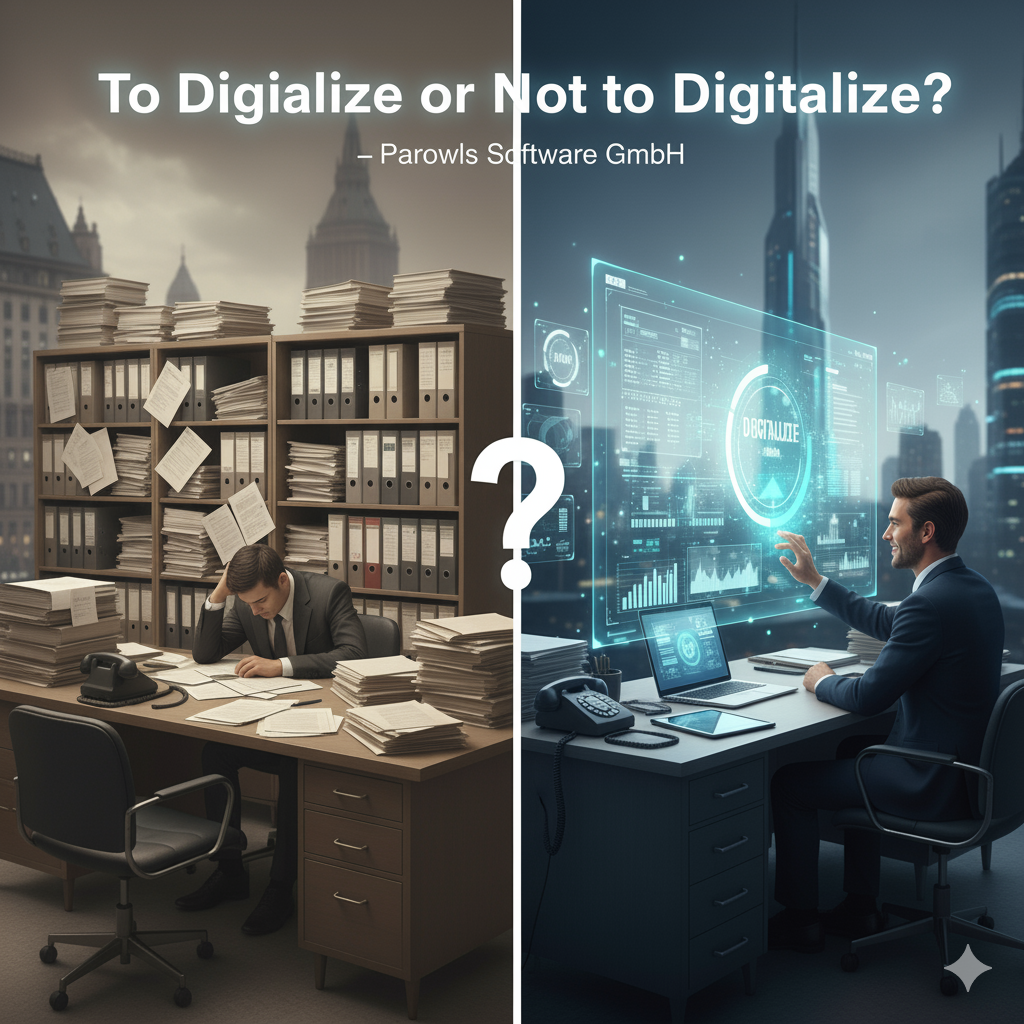Digitalization is everywhere. From AI-powered workflows to blockchain-secured records, the buzz is constant. But beneath the hype lies a more important question: Should you digitalize? And if so, how, when, and why?
At Parowls, we don’t treat digitalization as a checkbox. We treat it as a strategic decision—one that must be grounded in purpose, clarity, and long-term value. This post explores what digitalization really means, who it serves, and when it’s worth doing.
What Is Digitalization?
Digitalization is the transformation of business processes, services, and models using digital technologies. It’s not just about scanning documents or moving to the cloud. It’s about rethinking how your organization operates, delivers value, and adapts to change.
It’s the difference between:
- Digitizing a paper form (static)
- Creating a dynamic online workflow (interactive)
- Automating approvals based on smart rules (intelligent)
Digitalization is a mindset shift—from analog thinking to digital-first design.
What Are Its Forms?
Digitalization comes in many flavors. Here are a few common forms:
- Process automation: Replacing manual tasks with digital workflows (e.g., invoice approvals, onboarding)
- Customer experience enhancement: Chatbots, self-service portals, personalized dashboards
- Data-driven decision-making: Real-time analytics, predictive modeling, KPI tracking
- Platform integration: APIs connecting legacy systems to modern cloud services
- Remote collaboration: Digital workspaces, virtual meetings, shared repositories
- Blockchain applications: Immutable records, smart contracts, decentralized trust
Each form has its own use case—and its own risks. That’s why Parowls starts with strategy, not software.
Who Can Do It?
Any organization can digitalize. But not every organization should digitalize in the same way.
Success depends on:
- Leadership vision: Is there clarity on what digitalization is meant to achieve?
- Employee buy-in: Are teams ready to adopt new tools and workflows?
- Technical readiness: Are systems secure, scalable, and interoperable?
- Strategic alignment: Does digitalization support the business model—or distract from it?
Digitalization is not a one-size-fits-all solution. It’s a tailored journey. That’s where Parowls comes in.
How Does It Relate to Past Activities?
Digitalization doesn’t erase the past—it builds on it.
Think of it as a continuum:
- Digitization: Converting analog data to digital (e.g., PDFs, spreadsheets)
- Automation: Streamlining repetitive tasks (e.g., email triggers, batch processing)
- Digitalization: Reimagining processes with digital-first logic
Legacy systems, paper trails, and manual workflows often become the raw material for transformation. The goal isn’t to start from scratch—it’s to evolve with purpose.
Why Is It Done?
Organizations digitalize for many reasons:
- To improve efficiency
- To enhance customer satisfaction
- To enable scalability
- To stay competitive
- To unlock new business models
But here’s the catch: Digitalization must be done for the right reasons.
Doing it because “everyone else is” leads to wasted budgets, frustrated teams, and broken processes. At Parowls, we help clients define their “why” before touching the “how.”
What Will It Look Like in the Future?
Digitalization is evolving fast. In the near future, expect:
- AI-driven operations: Smart assistants, autonomous decision-making
- Blockchain-secured workflows: Transparent, tamper-proof records
- Hyper-personalized services: Tailored experiences based on behavior and context
- Decentralized ecosystems: Peer-to-peer platforms, tokenized value exchange
But the future isn’t just about tech. It’s about trust, ethics, and adaptability. Digitalization will become more invisible—embedded in everyday business logic and customer interactions.
Is It Repetitive or One-Time?
Digitalization is ongoing. Technologies evolve. Customer expectations shift. Regulations change.
It’s not a project—it’s a mindset.
Think of it like gardening. You don’t plant once and walk away. You nurture, prune, adapt. The same goes for digital systems. They need care, iteration, and strategic refreshes.
When Should It Not Be Done?
Digitalization isn’t always the answer. Here are scenarios where it might do more harm than good:
- Vanity projects: Digitalizing for prestige, not purpose
- Disruption of core human value: Replacing empathy with automation in sensitive contexts (e.g., healthcare, counseling)
- Lack of ROI: Investing in tech that doesn’t deliver measurable value
- Increased complexity: Introducing tools that confuse rather than clarify
Sometimes, the best solution is simplification, not digitalization.
Who Benefits?
When done well, digitalization benefits:
- Customers: Faster service, better experiences
- Employees: Less drudgery, more meaningful work
- Businesses: Greater agility, lower costs, new revenue streams
- Society: Sustainability, inclusion, transparency
It’s a win-win—when guided by strategy and ethics.
Who Loses?
But not everyone wins automatically. Digitalization can leave people behind:
- Skills gaps: Employees who aren’t trained or supported
- Poor design: Users overwhelmed by confusing interfaces
- Misalignment: Organizations that digitalize without clarity or cohesion
Losses happen when digitalization is rushed, reactive, or misaligned.
Can Losers Be Made to Win?
Yes—if we design with empathy and foresight.
Here’s how:
- Inclusive design: Interfaces that work for all users, not just tech-savvy ones
- Upskilling programs: Training and support for employees at every level
- Transparent communication: Clear messaging about changes and benefits
- Ethical tech choices: Prioritizing privacy, accessibility, and fairness
At Parowls, we believe digitalization should lift, not exclude.
Conclusion: Digitalization Done Right
Digitalization is not inherently good or bad. It’s a tool. And like any tool, its impact depends on how—and why—it’s used.
When done well, digitalization empowers people, streamlines operations, and unlocks new possibilities. When done poorly, it creates confusion, exclusion, and wasted effort.
At Parowls, we help clients digitalize with purpose, precision, and impact. We don’t chase trends—we solve problems. If you’re ready to explore what digitalization could mean for your business, let’s talk. Contact


